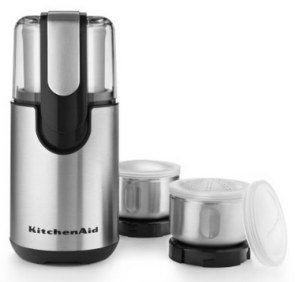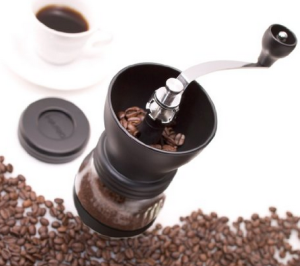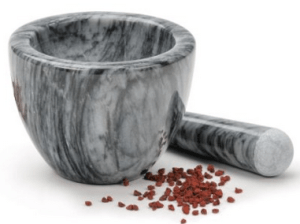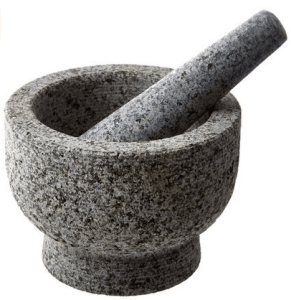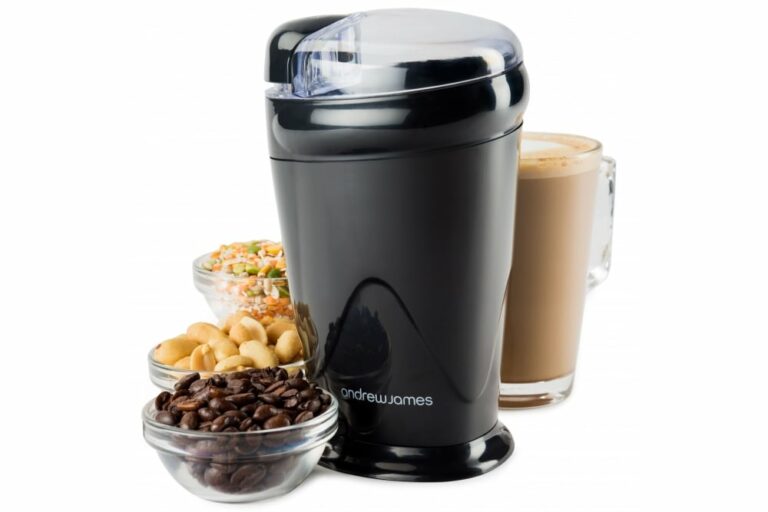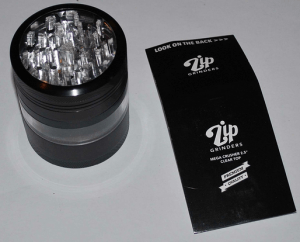What Else Can A Coffee Grinder Grind?
by Jeanette Kierstead
It may not completely surprise you to know that there are many other things that can ground up with a coffee grinder, other than coffee.
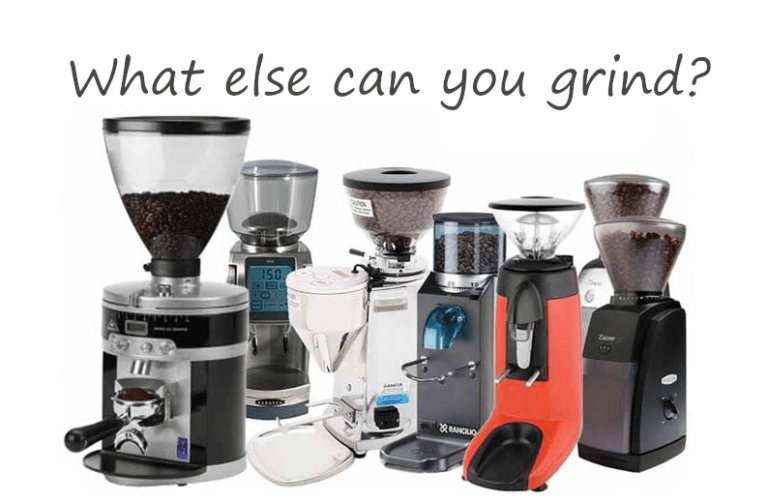
There are several things that come up again and again, with people continuing to ask about them all the time.
And so, we have compiled a list of frequently asked questions (FAQ) on the “can a coffee grinder grind…”, as well as some specific recommendations for particular grinder types that might be good for each substance you wish to grind.
Tablle of Contents
- Can a coffee grinder grind?
Let’s get right to it!
We’ll start by explaining whether a coffee grinder can grind spices.
Can a Coffee Grinder Grind Spices?
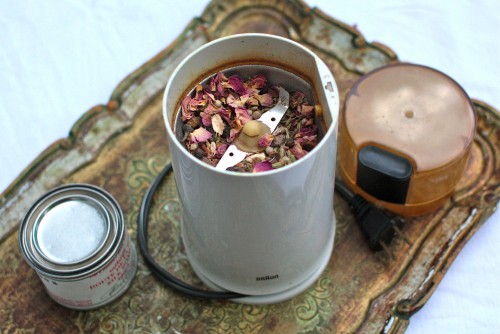
One of the most frequently asked questions is can a coffee grinder be used as a spice grinder?
Generally, the answer to this question is…it depends. As frustrating as this answer can be, it is true.
Ok then, what does it depend on? Since “spices” is such a broad term, and some spices are tougher to grind than others, it depends on both the grinder and the spice you intend to grind.
Most of the time people are wondering if the spice is too tough to grind, but its also worth thinking about if a spice is soft, which can have its own problems – like making more of a mess and smelling up the machine if you don’t clean it properly.
Oh, and if a spice has moisture – don’t even think about it! The moisture will rust your coffee grinder out (see more in the next section on food processors).
We think the best option is to actually buy a coffee grinder that advertises itself as a spice grinder, and there are many. In fact, many coffee grinders actually advertise and design their grinders specifically for grinding spices as well as coffee.
Burr Grinding Vs. Blade “Grinding”
Most often, spice grinders are blade grinders with specifically designed blades for “grinding” spices.
When it comes to blade grinders, technically speaking, they are actually slicing / dicing your spices, as opposed to “grinding” them, which is more like mashing.
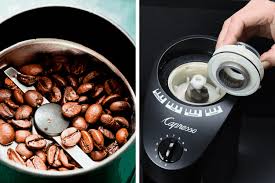
This goes for coffee, too. However, some would say it amounts to the same thing. When it comes to coffee, it really is not the same – blades do sometimes adversely affect the taste, especially with espresso – but with spices, blade grinders are really your best, cheapest, and quickest option.
Here’s a quick video of the Cuisinart SG-10 Spice & Coffee grinder, which does a great job of grinding most spices.
The bestselling KRUPS F203 is available for under $20 (depending where you buy), and it is actually advertised as a “spice and coffee” grinder, rather than the other way around. The reasons to get a grinder like this to grind spices is simple.
If you want to experiment with grinding a variety of spices, the KRUPS F203 spice and coffee grinder is cheap enough that if your experiment goes wrong, you’re only out $20, rather than $100 or more.
If you are a chef, chances are that you are still going to end up with one of these $20-ish grinders to grind your spices, because they are so darned effective, and we haven’t seen any super expensive spice grinders out there that do the job any better.
Spices that buyers of the KRUPS F203 have successfully ground up include: flax seeds, cinnamon, nuts, rice, oats, and really anything as hard or less hard than a coffee bean (and coffee beans are pretty tough themselves). It can also be used to chop up herbs.
Because the blade is so low in the housing with the KRUPS F203, this makes it a more effective grinder for just about anything you toss in there.
Of course, there are several coffee / spice grinders on the market, so the KRUPS F203 is not alone in this ability, although it is wildly popular with thousands of buyer reviews singing its praises.
Another model of grinder that is great for grinding spices is the KitchenAid BCG211OB (pictured below).
Some other important general questions you’ll want to ask with regards to grinding spices include:
- Exactly what are you grinding here – is it likely to be smelly or hard to clean?
- How easy to clean is your grinder?
- Is the material stainless steel or plastic?
- Are you also intending to use this for coffee or other flavors afterwards?
Grinding Spices With A Coffee Mill
When it comes to coffee mills, they too can be used to grind select spices. Obviously there are size restrictions, just like with your electrical blade grinders, and you should keep in mind that this time instead of using blades, you’ll be grinding with burrs.
| Baratza Encore Conical Burr Coffee Grinder |
|---|
| Cuisinart Dbm-8 Supreme Grind Automatic Burr Mill |
| Bodum Bistro Blade Grinder, Electric |
Grinding with burrs does change the game a little bit. Take a coffee mill such as the Hario Skerton, one of the more popular brands of burr mills available today. You need to keep in mind that because this is a coffee mill, it is not the same as a spice mill. The burrs are specifically designed for grinding coffee, although the bottom line is that yes, it does work for certain spices.
Here is a list of spices that grind well with the Skerton, and probably other mills as well, although we do recommend exercising caution lest you it gets broken:
- Allspice berries
- Cinnamon (though its not easy and might break your grinder)
- Cardamom seeds
- Cumin seeds
- Oregano
- Large crystal salt
- Wheat berries (again, another tough one, its risky but has been done)
- Rice (difficult, risky, but can be done)
All in all, coffee mills are not particularly meant for spices, but you can definitely get some use out of them for that reason. There is still one more option for spices we haven’t explored…
Grinding Spices With A Mortar & Pestle
If using an electrical spice blade grinder, or a burr mill doesn’t sound like the right method for you, there really is only one other practical option that people use to grind spices, which is the good old mortar and pestle.
As old-fashioned as it may seem, there are a few advantages to doing it this way.
Advantages Of The Mortar & Pestle
First of all, there’s actually less mess this way. Electrical blade grinders do make a bit of a mess with their fast, motor-driven chopping blades.
Even if all the action contained under a lid, you will have to clean it well in between grinding sessions or you will have the aroma of the last spice you ground lingering around still.
With a mortar and pestle, since there are no moving parts, its much easier to clean.
As it so happens, they are very similar in price to many of the electrical spice blade grinders, mainly because of the materials used, such as marble or granite.
One other advantages is you can use “wetter” spices in your mortar and pestle. Since its not mechanical, and you can clean it in a few seconds, there aren’t the same worries with moisture as there are with your electronic blade grinder.
The last thing we will will say about the mortar and pestle method is that, overall, it is probably a “better” method to grind spices.

Why is “better” in quotes like this? Well, for the same reason that grinding coffee is better with a manual mill or a burr grinder – it is less shocking on the substance being ground up, and, in many cases, this results in a better flavor. The quotes are because people can always debate this point.
Of course, these were the original grinders, so it stands to reason that if they are still being used today, there’s a good reason why.
This is the same reason doing anything by hand is generally superior. Faster? No. Better. Generally, yes. Just something to consider.
Lastly, here’s a video by Jamie Oliver showing proper mortar and pestle technique, and giving tips on how to maximize flavor.
Next, we discuss whether you can use your coffee grinder to process your food.
Can a Coffee Grinder be used as a Food Processor?
Even more broad of a term than “spices”, “food” is so broad as to suggest nearly anything.
Chances are that if you’re reading this, you most likely have a coffee grinder and you simply wish to see if you can use it the same way you use a food processor. That means, slicing and dicing up anything from nuts, to celery, to cheese. Wet stuff, dry stuff, anything really…
The short answer is: no.
Oh…you’re not going to take “no” for an answer, eh? Well then, the longer and more complicated answer is: well, kind of.
Once again, it really depends on what type of “food” you want to “process”. You need to at least ask yourself the one most important question before shoving that watermelon slice into your coffee grinder, and that is: can you get out and wash the grinding chamber separately?

Some of the cheaper blade grinders may not have detachable chambers which can be immersed in water.
If you are really determined to use your blade coffee grinder as a mini food processor, you really need to be able to wash it – and the blade – out afterwards. Otherwise, you’re liable to rust out any metal parts, or, just as bad, damage the electronic parts inside it.
With a burr mill, its the same thing – you’re probably going to gunk up the burrs if you use soft or wet food, and that’s not what they’re meant for. Dry stuff can work fine, but anything moist is not going to end well. Coffee beans are not 100% dry themselves, but they are by no means “wet”, which is why coffee burr mills work well with them.
If you’re dead set against getting an actual quality food processor like, say, the Hamilton Beach 70740 8-Cup Food Processor – which is, we might add, not much more expensive (maybe $10 more) than either a good coffee mill, mortar and pestle, or blade grinder – then we’ll do our best to direct you to a coffee grinder that can chop up a wide variety of food.
True, you might be able to save a few bucks this way, but there are legitimate advantages to using an actual food processor, if you read up on them.
What do we recommend?
Available for around $30 (*cough* same price as a food processor), the Secura Electronic Coffee & Spice Grinder this is a good choice if you haven’t got a lot of money and are looking for one small item to do an array of tasks.
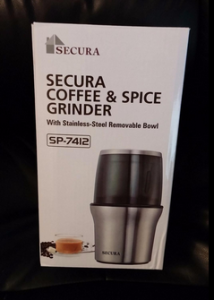
This is two removable grinding chambers with two sets of blades, perfect for grinding and chopping. It is designed with spice grinding in mind but can do coffee, nuts and so much more.
Plus, the Secura is very easy to clean, and so if you do use it for things other than coffee, make sure you clean it properly and often. It also comes with a removable bowl for added convenience.
Next, we talk about using a coffee grinder to grind nuts.
Can a Coffee Grinder be used to Grind Nuts?
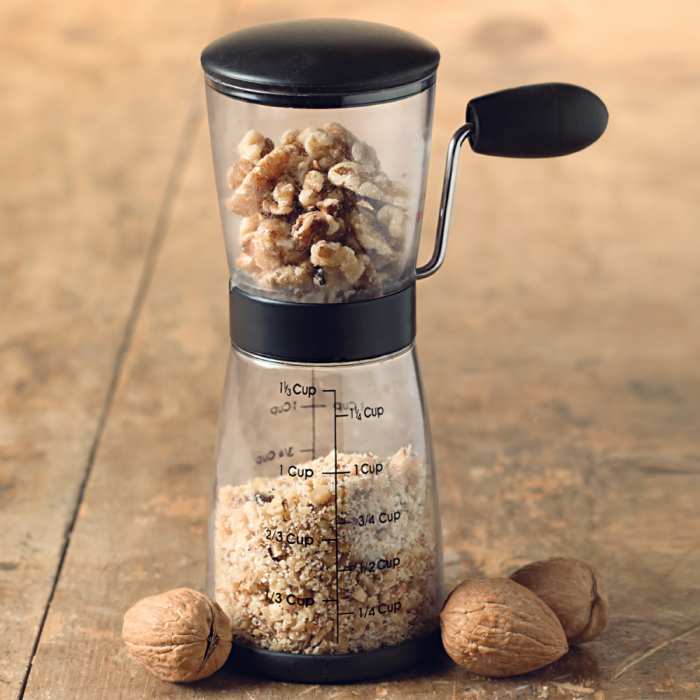
If you’ve been reading along this far, you should already know the answer, since nuts are similar to coffee beans in many ways – size, and even their toughness and texture.
If you’re just scrolling merrily along and you came to hear the answer of this specific question, the short answer is yes, but nuts (depending on the nut) can take their toll on your grinder. So, if you are going to be doing this regularly you may wish to get something properly equipped for the task.
What do we recommend?
For under $20, the durable Quiseen One-Touch Electric Coffee Grinder might be your best bet here, since it is one of the few grinders that advertises itself as being designed specifically for nuts, grains, and spices.
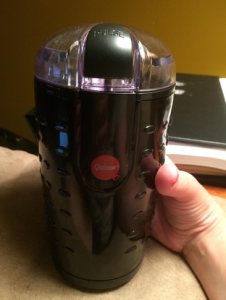
This model is on the reasonable end of the price range for a decent but straightforward blade grinder that does what it says on the package.
There’s a safety lock, graspable edging and clear lid so you can see what you are doing. The load capacity is 2.5 ounces, so it is not massive.
If you wanted anything bigger you would probably be looking at a food processor, in all honesty.
But, how about wheat berries? Can you use a coffee grinder to grind those? Keep reading to find out…
Can Coffee Grinders Grind Wheat Berries?
If you are looking to grind wheat with your coffee grinder, yes it is possible, but, once again, it depends what kind of coffee grinder you’re using. Certainly a bigger burr grinder can handle the job, as you can see in the video below:
As you can see, it seems to work fine with this type of grinder, but this is one of the more expensive coffee grinders out there, with a lot of horsepower behind it and strong burrs. The chances of anyone having an expensive coffee grinder lying around that you want to dedicate to wheat grinding is very unlikely.
So what about a smaller blade coffee grinder…will that work? As it turns out, not very well. As you can see in the following video, this woman used a cheaper blade coffee grinder to try to grind her wheat berries, and it didn’t go so well.
Wheat really needs to be milled, as it has always been, which means you’ll need to sacrifice your more expensive burr mill coffee grinder to even try milling or grinding wheat with it at home.
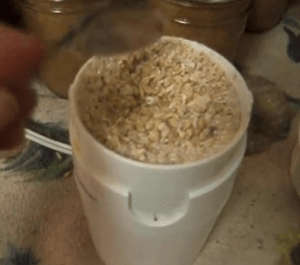
If you have a grinder that is smaller and blade-driven, its probably not going to work – at least not well.
Chances are if you are wanting to grind wheat yourself, you are going to want to get a larger quantity than you would get from one of these smaller grinders anyway, even if it did work well enough.

The good news is that flour mill grinders exist and are readily available for domestic kitchen use. The bad news is that they may be a little pricey so maybe you might want to make sure you are definitely getting your money’s worth out of it.
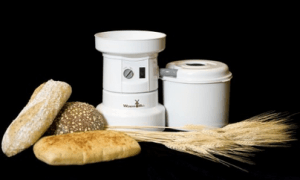
Some enterprising folks have come up with ways to make it work with their coffee grinder or even their blender, like this guy right here…
If you still want to try using your coffee grinder to grind wheat, then you run the risk of totally ruining your grinder, especially considering that if you put wheat through it, well, that’s gluten so all those poor gluten intolerant people can now no longer drink your coffee.
On top of that, some wheat that isn’t clean has debris in it that can ruin a good coffee grinder as well.
If you don’t want to heed these warnings, then just make sure your grinder has a fine grind setting. Like we said, the more expensive grinders will do the job, but with the cheaper blade models, you might just be spinning your wheels for a while and end up burning out the motor. Not worth it!
Next, we discuss whether you can grind rice in your coffee grinder.
Can Coffee Grinders Grind Rice?
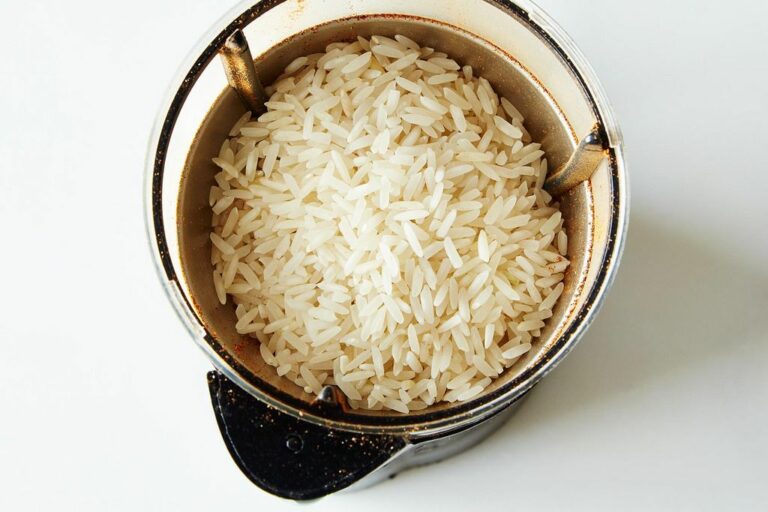
The word out “there” in rice grinding land is that, although it can be done with a mill, its excruciatingly slow, so it may be worth investing in something a bit more specialized if this is going to be a regular occurrence and to get a decent quantity.
That said, a KRUPS F203 words fairly well at grinding rice into something pretty close to the consistency of flour. Here is a quick video demonstration of using the KRUPS F203 to grind rice flour.
What do we recommend?
At under $100 (depending where you buy) and with a 32 ounce capacity, this is proper kitchen appliance territory.

Still, you might be better off with something like this, as you can get a decent quantity of flour in less time.
The Vitamix here is ideal for all the grains you may wish to grind, including using it to grind rice, wheat and other seeds with.
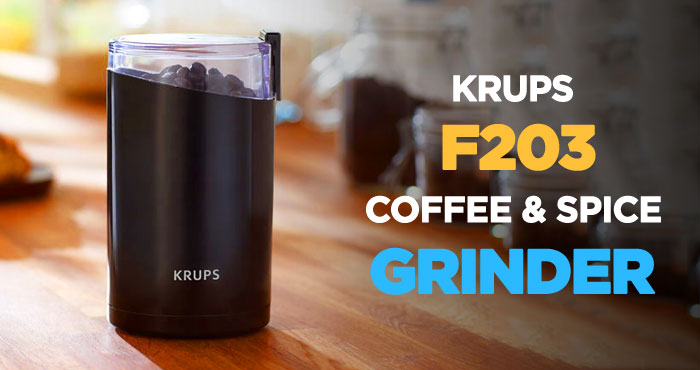
On the other hand, you could always just go with the KRUPS F203, which we mentioned earlier in this article. Its under $20, and it seems to do just fine with grinding rice, although it seems to take a while to get any substantial amount ground up.
Next, we talk about using your coffee grinder to grind flax seeds and chia seeds.
Can Coffee Grinders Grind Flax Seeds and Chia Seeds?
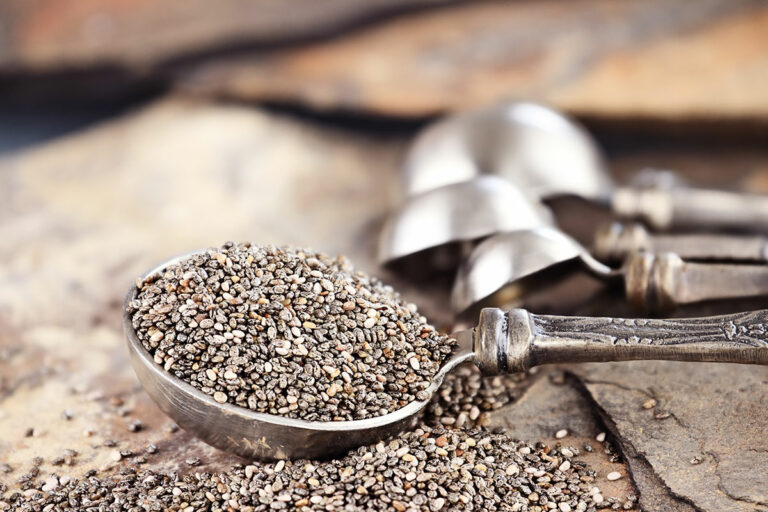
Whether a coffee grinder can grind flax seeds or can coffee grinders grind chia seeds are two other frequently asked and very popular questions. Both types of seeds have many health benefits, and they both have multiple uses. They are also perfect candidates for grinding, and so its only natural to think of a coffee grinder as one possible way to grind them up.
Chia Seeds
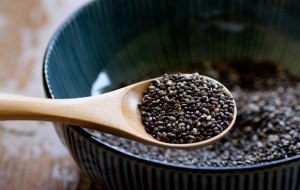
High in Omega 3, this could be the way to boost your calcium and niacin intake and a good supplement, as it can be added easily and is tasteless.
Flax seeds
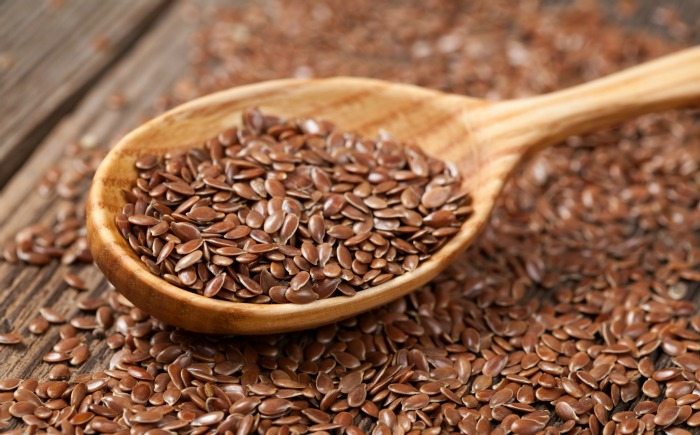
Also a source of Omega 3, flax seeds have vitamins and fiber and are associated as an aid to weight loss, as well as a supplement to combat menopausal symptoms.
If you’ve already decided to invest in the Vitamix, then this will be ideal. If you are still looking at a coffee grinder, there are several that should be ideal for this task.
What do we recommend?
As shown in the above video, the Hamilton Beach Custom Grind works perfectly for grinding both Chia and Flax seeds alike.
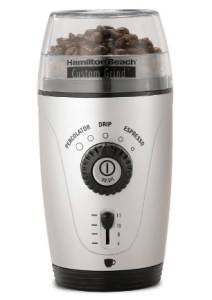
This is a bestseller and the original multi-tasker. Complete with a removable grinding chamber, for ease of cleaning, this can also deal with nuts, spices and some of the other substances and grains we have mentioned already in this article.
Priced under $20, it is not going to break the bank and worth a shot for a lot of your grinding needs.
Ahhh, finally.. The big question is whether you can grind weed in your coffee grinder.
Can Coffee Grinders Grind Weed?

Ah the perennial question. Actually, there’s a fair bit covered here in this full length article on the best weed grinders we wrote on this topic a while back as to the performance of coffee grinders and the magic medicinal substance, so you should definitely check that out if you *really* want to know.
But to cover it briefly. A lot here depends on how well you are going to clean out the said grinder and whether you are going to want to use it for coffee as well?
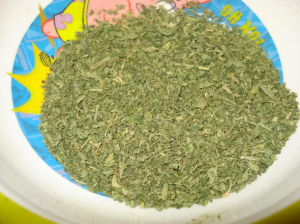
Can coffee grinders grind weed? Hell yes! But do you really want your coffee tasting of weed (hey, the answer to that question may well be another hell yes!) but if weed flavored coffee isn’t your bag, it may be best to keep the two things separate with a detachable chamber or you could try a dedicated grinder here.
What do we recommend?
Compact and under $20, the Secura Electric Coffee Grinder is back once again as an excellent choice as weed/coffee-grinder, since you must have come here looking to grind up your herb with a coffee grinder.
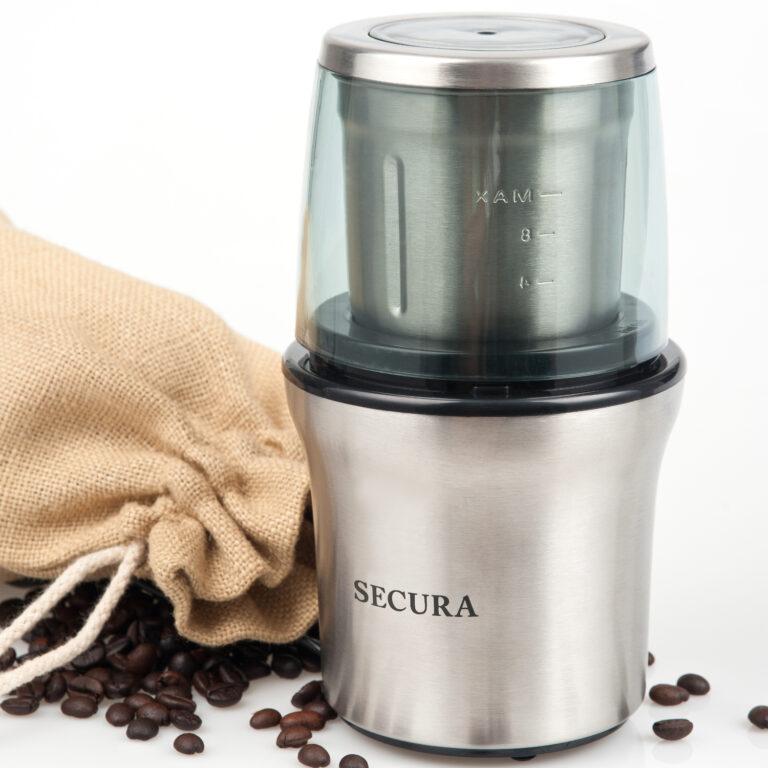
If you’re ok with a non-coffee-grinder for grinding your weed, there is a better option in the form of the Zip Large Spice Tobacco Herb Weed Grinder / Four-Piece With Pollen Catcher.
This isn’t at all a coffee grinder, but if you want something that will stop cross contamination with your espresso, it may be the best bet.
Not just for umm recreation, this can also be used in the kitchen for other spices and herbs, even legal ones!
Thanks for reading!
 |
 |
 |
 |

About Jeanette Kierstead
Jeanette has been testing and reviewing kitchen appliances for over six years now, so she knows her stuff when it comes to finding the best ones. In her spare time, she loves nothing more than baking cakes and cookies – especially if she can do so with one of her favorite stand mixers! When she's not in the kitchen, Jeanette is usually looking after everything homes-related; from garden tools to smart home products.
Thoughts on "What Else Can A Coffee Grinder Grind?"
 |
 |
 |
 |
Get FREE Coffee Gifts now. Or latest free grinders from our best collections.
Disable Ad block to get all the secrets. Once done, hit any button below
 |
 |
 |
 |
